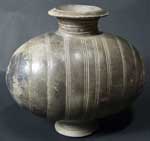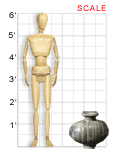VAM galleries including this work:
Berea College | Do You See a Pattern? || VAM Home
COCOON VASE, c. 206 BCE - 220 CE
Chinese, from the Han Dynasty (206 BCE- 220 CE)
Terracotta; 9" X 14"
2001.04.5
By permission of Berea College
Han Dynasty refers to the period in the history of Imperial China between 206 B.C.E. and 220 C.E. Several advancements in ceramics were made during this period: low-temperature lead glazes were developed, and ceramics began to be made for a variety of purposes, including ceremonial and utilitarian. The word “cocoon” in the title refers to the distinct, oblong shape of this vessel, which resembles the egg shape of a silkworm cocoon (silk was an important economic industry during the Han Dynasty). Since ceramics intended for burial sites were usually painted with ornate designs, the simplicity of this vase’s design suggests that it was intended for daily or household use. Its striped design is well balanced and attractive.
About the Han Dynasty
Military expansion, political centralization, and cultural achievements made the Han the first of Imperial China’s four greatest dynasties. The reign of the Han saw the gradual incorporation of Confucian ideals into government and the introduction of a new class of educated gentry. The Silk Road, an extensive network of trade routes that extended to the Roman Empire, was established during this period. Intellectual, literary, and artistic endeavors revived and flourished. Chinese history, geography, thought, and lore were compiled into encyclopedias. Technological advances included the invention of paper and lead-glazed ceramics as well as greatly improved silk-weaving techniques. Artfully decorated tombs indicate an emphasis on funerary art; the figures and geometric shapes carved into tombs provide clues to Han costumes, architecture, and aristocratic pastimes.
Classroom Ideas
Discussion: Would you have guessed that this clay vessel is somewhere around 2,000 years old? Why or why not? What about the vase might make you think it was more modern? Think about the different reasons we create art. If you were going to make a vase to hold flowers, would you design it differently than if it were to hold pencils?
Activity: Create your own cocoon-style vase with clay using the coil method. To make a coil pot, roll clay into coils about 1 inch thick. Form the pot’s base by making a spiral from one coil, pressing the sides of the coils closely together, and smoothing inside and out to a uniform thickness. Build up the walls by adding one coil at a time. Once you have the vessel made, smooth the surface of the clay. Think about how you would like to decorate your vase. Would you like it to be simple and clean or more ornate? Use a plastic knife or other clay tools to etch a design in the surface. When your piece has dried, add color with paint or glaze if you desire.
Links
Learn more about the history of Chinese funerary ceramics at the National Gallery of Australia.
[www.nga.gov.au/TTTsui/History/Han.cfm]
Read a brief history of the Han Dynasty at the Metropolitan Museum web site.
[www.metmuseum.org/toah/hd/hand/hd_hand.htm]

 Magnify
Magnify
